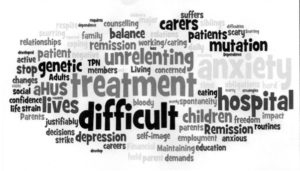“It’s BLOODY scary!”- An authentic aHUS Patients’ Voice
By Christmas 2011 nothing had been heard from the NHS about what format the patient group evidence would take. But work had begun.
There were two strands of research already taking place
- Although we had not knowingly met another aHUS patient until the first aHUS patients’ conference which had been held in Newcastle upon Tyne back in June 2011 ( and which led to the creation of aHUSUK) it was evident from those attending that conference that there was not a “typical” atypical HUS patient, instead there was a need to describe a “spectrum”.
- Similarly there were alternative treatment outcomes which were different and more extensive than just being on dialysis. Dialysis itself did not come alone and those living with it would encounter complications and debilitating conditions in time; particularly as they were not likely to get relief from dialysis from the opportunity of a kidney transplant.
Videos of the June conference were online and would be viewed and reviewed to get a better understanding of aHUS, its impact on aHUS patients and families. To get the orchestrated voice we needed adults and children (or their parents) , males and females, those speaking for patients who died , those on dialysis and /or plasma exchange who survived , those in remission and those few on eculizumab. We also needed family members.
The search was on , articles seeking help were written for kidney patient organisation magazines, postings were made about aHUSUK on the EURORDIS social medium Rare Connect and also the USA’s Foundation for children with atypical HUS website. Letters were written to those who had attended the Newcastle Conference but who had not come to Wimpole St. After several weeks we had candidates for each of the categories we had decided upon, except male adult patients. We knew of a handful of male patients by then but all were reticent to participate.
It was also evident that whilst Alexion knew about their drug and aHUS, it was weaker in its understanding of dialysis in its various forms and their co-morbidities. Comparing eculizumab costs with a dialysis “pack” cost plus plasma exchange was not enough , although the latter by normal treatment standards were expensive they were nowhere near the cost of eculizumab. But the cost of treating the co-morbidities, which although would not be experienced by all each year would be experienced by most at some time , some more that once. The search was on to provide such a list. Clearly our “ patients’ voice “ candidates would only provide some of these , particularly from those on dialysis for decades.
But there was another source. Those from around the world who had told their stories on the Rare Connect or the Children with aHUS websites provided considerable evidence and experience ,some the same, some novel and different. I began reading those websites and making notes of the additional treatments for co-morbidities reported by people around the world in the public domain. Even started a discussion forum about it. The aHUS social media is full of such valuable data for research. ( The “Good will come together” vision in practice)
Eventually as months passed by in 2012 the NHS got in touch with our “trustee for the patient voice” the role given to my daughter. AGNSS had decided that the patient group’s submission should take the form of a piece of a written qualitative research. The NHS would provide qualified resource to do the leg work but the topics to be covered were left to aHUSUK to decide. Another month passed and some consultants Two Can Associates were appointed. Working with the Patient Voice trustee a range of key heath and care questions were chosen to be used in the structured interviews with our “ patient voice panel”. The interviews would be held by the consultants either face to face or over the phone depending on the interviewee’s preference. The responses would be recorded and transcribed into written notes. Key themes from the responses would be identified and in some case illustrated with quotes from the interviewees.
Meanwhile a list of co morbidities was being drawn up to put in the research paper. Sadly there was no time to research the costs of the co-morbidity treatments.
Eventually a draft report was produced and at an all day meeting of aHUS trustees it was read, amended and approved. It was mid-May 2012 , the AGNSS meeting was to be held on 14 June 2012.
aHUSUK had got its written evidence done on time for the AGNSS Committee to read before the meeting.

Had it achieved no more, what aHUSUK had produced had fully justified the creation of the charity. It was to become an acclaimed and unique example of qualitative aHUS research. Had it not been held “in strictest confidence ” for the whole time that eculizumab was to be evaluated in the UK it would have been an excellent standalone research publication on the subject of aHUS.
( A version of it including more interviews with Welsh aHUS patients can be read by clicking aHUSUK-Experiences-Document )
However there was still more to be done to ensure the UK aHUS patient voice resonated fully with AGNSS and in an unemotional way the committe would see and understand what is was like living with aHUS.
“It is bloody scary”
*previous parts can be seen by clicking here
Len Woodward was a founding Trustee of aHUSUK and a founding affiliate of the aHUS alliance. He is also a Director Trustee of aHUS alliance Global Action. In this series of blogs Len Woodward explains and describes how he became an aHUS advocate and where the journey has been taking him to this day.

